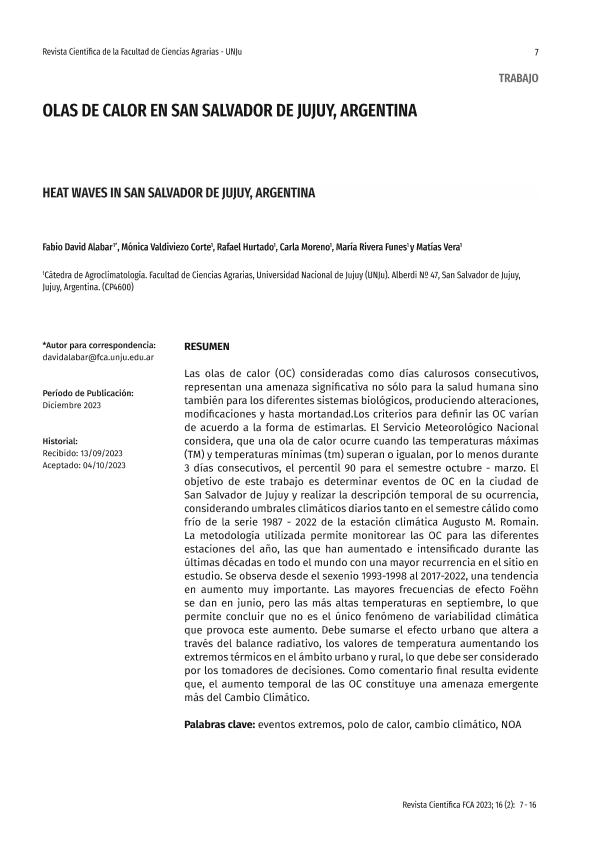Artículo
Las olas de calor (OC) consideradas como días calurosos consecutivos,representan una amenaza significativa no sólo para la salud humana sinotambién para los diferentes sistemas biológicos, produciendo alteraciones,modificaciones y hasta mortandad.Los criterios para definir las OC varíande acuerdo a la forma de estimarlas. El Servicio Meteorológico Nacionalconsidera, que una ola de calor ocurre cuando las temperaturas máximas(TM) y temperaturas mínimas (tm) superan o igualan, por lo menos durante3 días consecutivos, el percentil 90 para el semestre octubre - marzo. Elobjetivo de este trabajo es determinar eventos de OC en la ciudad deSan Salvador de Jujuy y realizar la descripción temporal de su ocurrencia,considerando umbrales climáticos diarios tanto en el semestre cálido comofrío de la serie 1987 - 2022 de la estación climática Augusto M. Romain.La metodología utilizada permite monitorear las OC para las diferentesestaciones del año, las que han aumentado e intensificado durante lasúltimas décadas en todo el mundo con una mayor recurrencia en el sitio enestudio. Se observa desde el sexenio 1993-1998 al 2017-2022, una tendenciaen aumento muy importante. Las mayores frecuencias de efecto Foëhnse dan en junio, pero las más altas temperaturas en septiembre, lo quepermite concluir que no es el único fenómeno de variabilidad climáticaque provoca este aumento. Debe sumarse el efecto urbano que altera através del balance radiativo, los valores de temperatura aumentando losextremos térmicos en el ámbito urbano y rural, lo que debe ser consideradopor los tomadores de decisiones. Como comentario final resulta evidenteque, el aumento temporal de las OC constituye una amenaza emergentemás del Cambio Climático. Heat waves (HW), considered as consecutive hot days, represent a significant threat not only to human health but also to different biological systems, producing alterations, modifications and even mortality. The criteria for defining HW vary according to the way to estimate them. The National Meteorological Service considers that a heat wave occurs when the maximum temperatures (MT) and minimum temperatures (mt) exceed or equal, for at least 3 consecutive days, the 90th percentile for the October - March semester. The objective of this work is to determine HW events in the city of San Salvador de Jujuy and make a temporal description of their occurrence, considering daily climatic thresholds in both the warm and cold semesters of the 1987 - 2022 series of Augusto M. Romain weather station. The methodology used allows monitoring the HW for the different seasons of the year, which have increased and intensified during the last decades throughout the world with a greater recurrence in the site under study. A very important increasing trend is observed from the six-year period 1993-1998 to 2017-2022. The highest frequencies of the Foëhn effect occur in June, but the highest temperatures in September, which allows us to conclude that it is not the only climate variability phenomenon causing this increase. In addition, the urban effect, which alters temperature values through the radiative balance, increasing thermal extremes in urban and rural areas, must be considered by decision makers. As a final comment, it is evident that the temporary increase in HW constitutes another emerging threat from climate change.
Olas de calor en san salvador de Jujuy, Argentina
Título:
Heat waves in san salvador de Jujuy, Argentina
Alabar, Fabio David ; Valdiviezo Corte, Monica Beatriz; Hurtado, Rafael Horacio; Moreno, Carla; Rivera Funes, María del Carmen; Vera, Matías
; Valdiviezo Corte, Monica Beatriz; Hurtado, Rafael Horacio; Moreno, Carla; Rivera Funes, María del Carmen; Vera, Matías
 ; Valdiviezo Corte, Monica Beatriz; Hurtado, Rafael Horacio; Moreno, Carla; Rivera Funes, María del Carmen; Vera, Matías
; Valdiviezo Corte, Monica Beatriz; Hurtado, Rafael Horacio; Moreno, Carla; Rivera Funes, María del Carmen; Vera, Matías
Fecha de publicación:
12/2023
Editorial:
Universidad Nacional de Jujuy. Facultad de Ciencias Agrarias
Revista:
Revista Científica de la Facultad de Ciencias Agrarias
ISSN:
0328-8080
Idioma:
Español
Tipo de recurso:
Artículo publicado
Clasificación temática:
Resumen
Palabras clave:
eventos extremos
,
polo de calor
,
cambio climático
,
NOA
Archivos asociados
Licencia
Identificadores
Colecciones
Articulos(INECOA)
Articulos de INSTITUTO DE ECORREGIONES ANDINAS
Articulos de INSTITUTO DE ECORREGIONES ANDINAS
Citación
Alabar, Fabio David; Valdiviezo Corte, Monica Beatriz; Hurtado, Rafael Horacio; Moreno, Carla; Rivera Funes, María del Carmen; et al.; Olas de calor en san salvador de Jujuy, Argentina
; Universidad Nacional de Jujuy. Facultad de Ciencias Agrarias; Revista Científica de la Facultad de Ciencias Agrarias; 16; 12-2023; 7-16
Compartir



